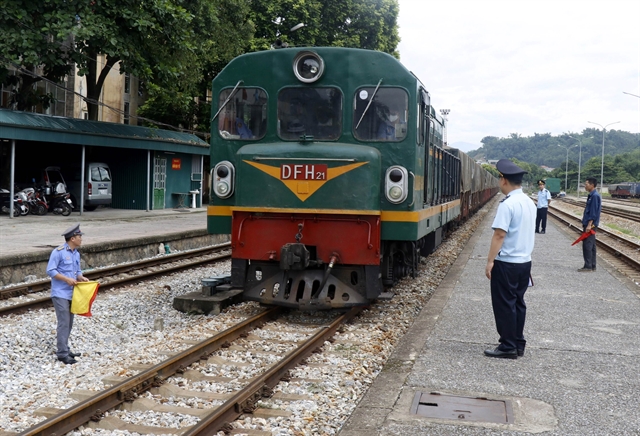 Economy
Economy


|
| A cargo train the Lào Cai Railway Station. — VNA/VNS Photo |
HÀ NỘI — Việt Nam and China need to enhance development of transport and logistics services along the economic corridor of four Vietnamese provinces and cities - Lào Cai, Hà Nội, Hải Phòng and Quảng Ninh - and Yunnan province, China, according to experts.
According to Phạm Văn Huy, Deputy Director of Hải Phòng Department of Transport, in order to develop transport infrastructure associated with logistics of Hải Phòng seaports, investment needs to be prioritised.
Hải Phòng City will develop an inter-provincial and inter-regional traffic system as well as speed up the completion of roads connecting with the coast.
It also proposes renovation of the Hà Nội - Hải Phòng railway to increase its speed and effectiveness and accelerate the building of passenger terminal 2 and expansion of the apron and cargo terminal at Cát Bi International Airport.
Quảng Ninh Province has said it will continue to attract investment in a number of important seaports such as: Con Ong - Hòn Nét, Mũi Chùa and Yên Hưng ports, and Hải Hà Seaport Industrial Park.
It will also research and synchronously deploy the national high-speed and railway system to form a synchronous transport infrastructure system.
Along with that, Quảng Ninh will soon form inter-regional logistics centres, connecting domestic and international goods transportation activities. Those are formed on the basis of existing expressways and national highways, such as Nội Bài - Hạ Long, Hạ Long - Vân Đồn, and Vân Đồn - Móng Cái, to link to Hà Nội.
According to Nguyễn Huy Hoàng from the Transport Development and Strategy Institute under the Ministry of Transport, logistics infrastructure on the economic corridor of Kunming (Yunnan) - Lào Cai - Hà Nội - Hải Phòng - Quảng Ninh has developed strongly, especially transport infrastructure.
Hoàng believes that there is still room for Yunnan province and these four Vietnamese localities to exploit benefits from the inter-regional railway system, further promoting the development of the localities on the corridor.
The two sides needed to continue to improve logistics infrastructure on the corridor according to national and local master plans, he said, focusing on the development, renovation and upgrading of the railway network among the five localities.
Hoàng also said that it was necessary to build a new Lào Cai - Hà Nội - Hải Phòng - Quảng Ninh railway line with a 1,435mm gauge because this would be the route that holds nearly 50 per cent of the cargo and passenger volume transported by the national railway system.
To develop the railway line, he recommended developing key routes at the East and West of Hà Nội and the route to Lạch Huyện seaport, Hải Phòng to take advantage of the railway industry.
"Lào Cai has an important position in this economic corridor," said Đặng Văn Lương, deputy director of the Lào Cai Department of Transport, adding that the new 1,435mm railway on the Lào Cai - Hà Nội - Hải Phòng route would help reduce transport time and costs, facilitating import and export activities between the two countries due to having the similar railway gauge.
Phạm Văn Nghị, deputy director of the Hải Phòng Department of Transport, also proposed renovation of the Hà Nội - Hải Phòng railway to increase the speed and effectiveness.
In addition, Nghị suggested that the Government and ministries and branches focus resources on upgrading the Lào Cai - Hà Nội - Hải Phòng - Quảng Ninh railway to promote the advantages of the railway connection between the localities along the economic corridor with the seaport system of Hải Phòng and Quảng Ninh.
As the economic hub of the northern region, Hà Nội has favourable conditions to become a leading logistics hub. According to the city's Department of Transport, the capital is well connected to all provinces and cities in the north, with nearly 23,300 km of roads and highways, including the Pháp Vân - Cầu Giẽ highway, the Nội Bài - Lào Cai highway, and the 5B highway. Hà Nội's network of railways and waterways also reaches out to other provinces and cities in the north.
However, there are still bottlenecks hindering the transport and logistics network from being developed further, such as incomplete infrastructure, traffic congestion and urban flooding, according to Đỗ Việt Hải, deputy director of Hà Nội's Department of Transport. Those problems make logistics activities inconvenient, increase transportation costs and reduce the quality of services.
Hà Nội's authorities need to adopt digital solutions in urban planning and management of transportation infrastructure, especially the use of Building Information Model (BIM) in the design, construction and operation of that infrastructure, according to Hải. The city should also push up use of smart devices to monitor traffic and regulate the flow of vehicles.
According to Zhou Minxin, deputy director of the Yunnan Provincial Development and Reform Commission, the construction of the China-Việt Nam standard railway line is beneficial to the economic and trade development between China and Việt Nam.
Chen Yue, deputy director of the Yunnan Department of Transport, also expressed hopes that Việt Nam would complete the review of the standard gauge railway planning of Lào Cai - Hà Nội - Hải Phòng as soon as possible, speeding up Construction progress of China-Việt Nam standard gauge railway.
At the same time, the two countries needed to restore the initial routes from Yunnan to Việt Nam and open new routes according to market demand, building network transporting cargos and strengthening Yunnan - Việt Nam civil aviation cooperation. — VNS